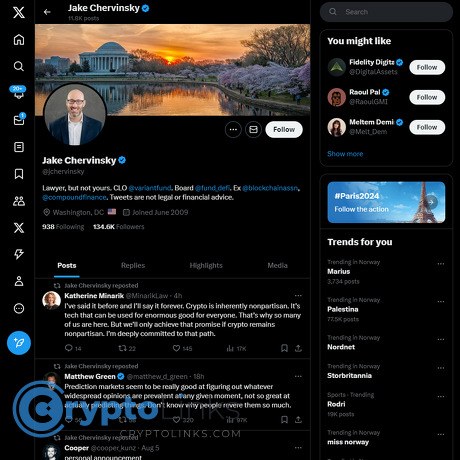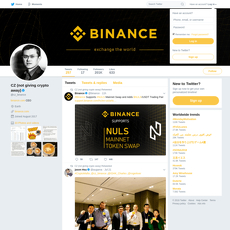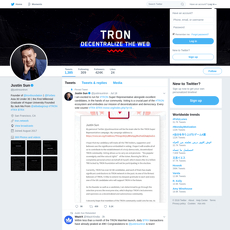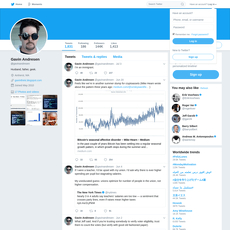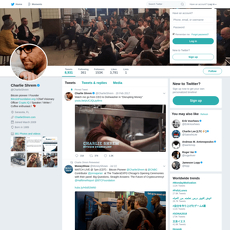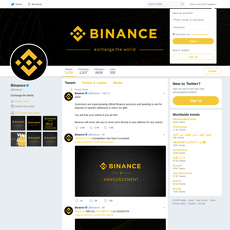Jake Chervinsky Review
Jake Chervinsky
x.com
Jake Chervinsky Review Guide: How His X Posts Help You Make Sense of Crypto Policy (and What To Watch Out For)
Ever scrolled through crypto Twitter during a big SEC moment and thought, “Wait, what actually matters here?”
Same. That feeling is exactly why so many people follow @jchervinsky on X. When the policy firehose turns on, he’s one of the few voices that can cut through the noise and explain what a filing or hearing really changes — and what it doesn’t.
The problem most of us hit during crypto policy news
Policy news is messy. You’ve got legal jargon, anonymous “sources,” and hot takes flying faster than the PDFs load. One confused headline and the market mood flips.
Real-world examples:
- False ETF frenzy (Oct 2023): A bogus post about a spot Bitcoin ETF approval sent BTC spiking before the truth caught up. Classic rumor → overreaction. Source: Reuters.
- Ripple summary judgment (July 2023): Many read this as “XRP is fully in the clear.” Not quite. The ruling split sales types, and the nuance mattered for everything from listings to enforcement chatter. Source: Justia docket.
- Grayscale v. SEC (Aug 2023): The court told the SEC its denial was arbitrary, which was important — but it wasn’t the same as a blanket ETF approval, even though many tweets framed it that way. Source: Reuters.
And yes, the internet makes this worse. False or sensational claims spread faster than accurate ones, especially in breaking-news cycles. That’s not me being cynical — that’s been shown in research on social networks and misinformation (see MIT’s study on how false news spreads faster than truth). Source: Science (MIT/Vosoughi et al.).
The bottom line: Without quick, trustworthy context and links to primary sources, you either panic, overreact… or miss what actually matters.
The plan: how this guide helps you use @jchervinsky the smart way
I’ll show you how I read and assess @jchervinsky during policy-heavy weeks so you can:
- Spot the signal in his posts during breaking news
- Avoid the common traps (rumors, misread filings, hype)
- Cross-check his take in minutes with primary docs
- Turn policy updates into calm, practical next steps
Short version: you’ll get a simple system — what to watch, what to ignore, and how to move from “Twitter noise” to “actionable clarity.”
Who this guide is for
- Founders and builders who want early signal on rules that affect products and launches
- Traders and analysts who need clean policy context (not noise)
- Researchers and journalists who value primary-source links and clear framing
- Everyday crypto users who just want trustworthy explanations
Quick takeaway
Jake is strong on reliable context and cautious analysis around U.S. crypto policy. He’s not giving legal advice or trading signals. What he does well: explain what’s real, flag what’s still unknown, and map out what to watch next — often with links to the documents you actually need.
Ready to put a face and track record to that handle you keep seeing on your feed? In the next section, I’ll share who Jake is, what he posts about, and why the industry pays attention. Curious what makes his updates stand out when the SEC or a judge drops news?
Who is Jake Chervinsky?
Short background
Jake Chervinsky is an attorney who specializes in crypto law and policy. He’s built a reputation for translating complex legal moves into plain English, especially when the SEC, CFTC, or Congress puts crypto in the spotlight. On X, you’ll find him at @jchervinsky, where he’s known for calm, source-linked breakdowns that keep people focused on what actually matters.
“In crypto policy, what you don’t know can cost you—context is alpha.”
What stands out is his restraint. He’s quick to say what we know, what we don’t, and what comes next. That tone is rare—and valuable—on a platform that rewards hot takes.
What he posts about
- Regulatory and enforcement actions: SEC/CFTC complaints, settlements, and court orders that affect exchanges, tokens, staking, and lending.
- Stablecoin and market structure policy: how potential rules could shape liquidity, listings, and custody.
- Congressional activity: hearings, markups, and bills—what’s real progress vs. political theater.
- Strategy and signal: why a filing matters, how to think about timelines, and where uncertainty still lives.
To make this concrete, here are the kinds of moments where his posts tend to help:
- Big court rulings that move the goalposts: When federal courts question an agency’s reasoning or set a new precedent, he usually explains the holding in normal language and what the next procedural step could be. For past examples like the Grayscale-SEC battle over spot ETFs, he focused on the narrow legal point and reminded everyone what wasn’t decided yet. You can cross-check court opinions on the D.C. Circuit site: cadc.uscourts.gov.
- Enforcement weeks: When the SEC drops complaints or settlements, he often links the press release, notes the posture (complaint vs. ruling), and flags key theories that could affect other projects.
- Stablecoin debates: During House Financial Services Committee hearings, he breaks down the real policy choices—reserves, issuer oversight, and payment rails—so you can separate substance from posture. Committee updates land here: financialservices.house.gov.
- Market structure bills: When comprehensive frameworks move (for example, the market structure bill FIT21 in the 118th Congress), he outlines who gains authority, what changes for exchanges and tokens, and what still needs work. Bill text and status: congress.gov/bill/118th-congress/house-bill/4763.
Why the industry listens
Two big reasons: sources and restraint. He links filings, orders, and bill text, and he avoids the all‑caps panic that turns timelines into noise. That actually matters for signal: a well‑known study in Science found that false news spreads faster than truth on social platforms, largely because emotional content gets amplified (Vosoughi, Roy, Aral, 2018). A measured legal explainer with receipts is the antidote.
He’s also great at labeling uncertainty. If a court issues a procedural order, he’ll say so. If a rule is a proposal (not final), he flags the comment period. That kind of clarity helps founders, analysts, and everyday users avoid costly misreads.
And yes, he writes like someone who’s actually read the document. Expect plain-English summaries, definitions of terms that trip people up, and short checklists of what to watch next.
Where to find him and how often he posts
- Main feed: x.com/jchervinsky
- Cadence: bursts around filings, hearings, deadlines, and agency announcements—quiet when there’s no real news.
If you’ve ever felt that knot in your stomach during “SEC week,” you’ll appreciate how his updates steady the room. Want to see exactly what you’ll get from following him—threads, timelines, and the kind of context that saves you hours? Let’s check that out next.
What you’ll get by following @jchervinsky
Clear context during breaking news
When policy news hits, speed without clarity is a trap. Jake’s updates focus on what just happened, what it actually means, and what comes next—not drama. That saves you from reacting to the loudest headline in the room.
Real-world feel for what you’ll see on his feed when the tape is hot:
- Spot ETF moments: Quick breakdowns of the difference between approvals on Form 19b-4 vs. S-1 effectiveness, with the immediate takeaway (e.g., when trading can actually start) and what to monitor next (flows, spreads, creation/redemption mechanics).
- Big enforcement drops: A plain-English summary of the complaint, the legal test in play (think Howey factors), and the current stage of the case so you don’t confuse a filing with a final ruling.
- Court orders and appeals: Clear explanation of what the court did (deny, grant, remand), whether it sets precedent, and the realistic timeline for the next procedural step.
“Clarity beats speed. In crypto policy, the first take is rarely the right take.”
There’s a reason this approach helps. The 2018 Science study by Vosoughi, Roy, and Aral found that false news spreads faster than the truth on social platforms. Accounts that slow the scroll with primary sources and careful framing reduce that risk. That’s the kind of feed you want during chaos.
Useful threads and quote posts
Expect threads that do three things well:
- Anchor in sources: Links to the actual filing, press release, or bill text so you can click once and verify. Primary docs beat takes, every time.
- Pull the key paragraph: He’ll often quote the exact section that matters (e.g., how the agency defines “investment contract” in this case) so you’re not guessing what the argument hinges on.
- Explain why it matters: One or two lines on how it affects exchanges, stablecoins, staking, or token distribution models—without pretending it answers every question on day one.
That format is gold when you don’t have an hour to read a 60-page order. Communication research consistently shows that people judge information as more credible when it includes direct citations. Threads with receipts win.
Topics he covers well
- Enforcement actions (SEC/CFTC/DOJ): What the agency alleged, which tests apply, and whether the case is at complaint, motion, or ruling. You’ll often get a practical “don’t overread this yet” reminder.
- Stablecoins and market structure: Where reserve requirements, issuer rules, and exchange definitions could land—and how that shapes product strategy in the U.S.
- U.S.–global policy linkages: How a U.S. move rhymes (or clashes) with EU/MiCA, UK, or APAC frameworks, so you don’t think America is the whole map.
- Timelines that actually matter: Hearings, comment periods, and appeal windows. If you make decisions on catalysts, those dates are your edge.
Example of the kind of clarity you can expect on a complex day: “Ruling on a motion to dismiss isn’t a merits decision; it tests the complaint’s sufficiency. Discovery or summary judgment could tell the real story.” That single line prevents costly overreactions.
Ideal use cases
- Founders: Sanity-check launch risk. If a new action targets a model similar to yours, you’ll get a fast read on whether the facts line up—or don’t—and what to watch on timing.
- Analysts: Frame your catalyst map. Pair his “what’s next” dates with your models so research notes don’t miss the procedural clock.
- Reporters: Grab the right paragraph and the right link. Quote the filing, not the rumor. Your editor will thank you.
- Everyday users: Understand what’s signal vs. FUD without needing a law degree. If you’re about to panic-sell on a headline, these threads are your circuit breaker.
Now, here’s the kicker: not every calm thread is good, and not every bold take is bad. The real question is how to tell strong signal from confident noise—fast. Want my simple checklist for judging his posts (and anyone else’s) in under two minutes? Keep reading…
How I evaluate his signal (and how you can too)
If you’ve ever felt your heart rate spike during a big SEC moment, you’re not alone. That’s exactly when I want calm, source-backed signal — not hype. Here’s the simple way I read Jake’s posts so I can move fast without getting burned.
“Panic is not a strategy.” When the headlines get loud, I slow down and check the primary link. Every time.
Track record and tone
Jake’s strength is measured, timely context. He tends to under-promise and over-explain. That tone matters in policy, where one word can shift the meaning of an entire order.
- ETF nuance when everyone wanted fireworks: During the spot Bitcoin ETF approvals (Jan 2024), plenty of posts screamed “it’s live now.” Jake emphasized the difference between an exchange rule change (19b-4 approval) and the fund’s registration statements (S-1 effectiveness) — a small but market-moving distinction. The SEC’s own release confirmed the process had multiple parts (SEC Press Release).
- “Complaint ≠ conviction” clarity: When major exchanges were sued in 2023, he reminded followers that a complaint starts a case; it doesn’t decide it. That framing helped temper knee-jerk “end of crypto” takes and focused attention on the procedural next steps (motions, hearings, possible settlements).
- Ripple realism: After the 2023 summary judgment split, he broke out what the court actually ruled (programmatic sales vs. institutional sales) and flagged that appeals and remedies were still in play. No victory laps, just what changed and what didn’t.
That consistency — cautious, source-linked, next-step oriented — is why I treat his posts as a stabilizer in volatile news cycles.
Bias and point of view
He’s pro-innovation and rights-focused, which lines up with much of the crypto policy community. I’m fine with that — I just keep a mental note that everyone brings a lens.
- How I balance it: I pair his take with at least one other legal voice and the official doc (SEC/CFTC release, the court order intro, or the bill text on Congress.gov). If the views converge on facts but differ on implications, that’s healthy tension — not a red flag.
- Why this matters: Research shows false or emotionally charged news spreads faster than accurate updates, especially on X. The MIT study on misinformation found false stories were ~70% more likely to be retweeted than true ones (Science, 2018). A measured POV helps counter that pull.
Fast fact-checking workflow
Here’s my 3-minute triage when a Jake post hits during breaking news:
- 1) Find the link. He usually includes the filing, press release, or bill. No link? I slow down.
- 2) Identify the posture in 10 seconds. Is this a complaint, motion to dismiss, preliminary injunction, summary judgment, final rule, or a settlement/consent order? If you’re unsure, Cornell’s definitions are clutch (Cornell LII).
- 3) Read the first page + conclusion. You’ll catch the holding or ask, the parties, and the immediate implications. Most of the “gotchas” live here, not in the hot takes.
- 4) Check dates and countdowns. Note filing dates, comment periods (often 21–60 days on rule proposals), hearing dates, or appeal windows. Timing is where trades and roadmaps get mispriced.
- 5) Log the “unknowns.” Jake often flags what we don’t know yet — enforcement focus, scope of impact, or pending follow-ups. Those unknowns are your risk box. Write them down.
- 6) Cross-check once. Compare with one other credible legal source or the agency thread. If both say the same thing about posture and timing, I move on. If they diverge, I pause.
Two quick real-world cues:
- Rule filings versus effectiveness: Exchange rule changes under Section 19(b) can be approved while a fund’s registration is still pending. Treat them as separate gates.
- Court wins versus precedents: A district court order may not be binding beyond that case. Appeals can narrow or expand impact. The “what’s next” line in Jake’s threads is the map.
Red flags to avoid (from any account)
- No documents, big claims. If there’s no link to the filing or release, I assume it’s incomplete at best.
- “This changes everything” without specifics. Real legal impact usually shows up in the holding and remedy, not in slogans.
- Overconfident timelines. Courts and agencies shift calendars. Anyone giving hard dates without a docket or agency notice is guessing.
- Selective screenshots. A cropped paragraph can reverse meaning. I always open the full PDF and search for the key terms.
- Rumor amplification. Be extra cautious with “hearing whispers” posts. The MIT data on false-news virality is a good reminder to wait for the source.
The goal isn’t to be perfect — it’s to be consistently right on posture, timing, and next steps. That’s how you turn crypto policy noise into actual signal. Want my exact alert setup and the 3-tap workflow I use to scan his threads in under three minutes?
Power tips: Using his feed the smart way
“In a sea of noise, clarity isn’t a luxury — it’s an edge.”
When X explodes with “BREAKING” alerts, your heart rate spikes and the timeline turns into a shouting match. Here’s how I keep calm, use @jchervinsky’s posts as clean signal, and turn them into real next steps without getting buried.
Set up alerts without getting overwhelmed
I want fast context, not constant pings. This setup keeps me focused and ready when it counts.
- Build a Policy + Legal List: Add @jchervinsky and 2–3 other credible legal/policy accounts. View this List in a column (X “Decks” or TweetDeck-style tools) so headlines don’t flood your main feed.
- Time-bound notifications: Hit the Bell on Jake’s profile only during heavy news windows (hearings, rulings, agency announcements). Outside those windows, turn it off. Research shows batching notifications reduces stress and context switching, which kills focus (APA; see also evidence on fewer checks lowering stress: Kushlev & Dunn, 2015).
- Use smart search shortcuts:
- from:jchervinsky SEC filter:links — only his posts with links (usually primary sources).
- from:jchervinsky “comment period” — find deadlines you can add to your calendar.
- from:jchervinsky (stablecoin OR “market structure”) — narrow to topics that matter to you.
- Scope by time: since:2024-01-01 until:2025-01-01 to review a full year.
- Route big stuff to Slack/Email (optional): An automation tool can push any new @jchervinsky post containing “SEC” or “ruling” straight into a #policy channel so your team sees it fast.
Read threads efficiently
Jake’s threads usually follow a consistent arc. Skim smart, then go deeper only if it hits your roadmap or portfolio.
- First tweet = framing: What happened, and why it matters. If it’s outside your scope (e.g., a niche case), move on.
- Middle tweets = receipts: Open the quoted document in a new tab. Skim the summary/intro, the requested relief, and any timeline sections.
- Final tweet = what’s next: This is gold. Pull dates, agencies, and decision points. Add them to your calendar immediately. External reminders boost follow-through in real life (prospective memory research backs this up; e.g., implementation intentions literature).
My 90-second note template (copy/paste):
- What happened: [one line]
- Who decides next: [judge/committee/agency]
- Key date(s): [hearing/comment deadline/appeal window]
- Unknowns: [Jake’s “we don’t know yet” list]
- Impact risk: [low/med/high for my product/positions]
Cross-check in minutes
Two sources + one primary document will keep you out of trouble during breaking news.
- Open the primary doc Jake links: Complaint, motion, order, agency release. Read the intro and the section titled “Background,” “Holding,” or “Conclusion.”
- Verify with one additional credible account: Look for another legal analyst summarizing the same filing. You want alignment on facts, differences on interpretation.
- Log the “unknowns” he flags: Those open questions are where narratives swing. Keep a tiny tracker for them; update as new info lands.
- Fast official sources:
- SEC press releases: sec.gov/news/pressreleases
- CFTC press releases: cftc.gov/PressRoom/PressReleases
- Court dockets (free via RECAP): courtlistener.com
- Federal Register (comment periods): federalregister.gov
- Congressional text & status: congress.gov
Why this works: Interruptions wreck productivity — it can take around 20+ minutes to refocus after a disruption, according to attention research by UC Irvine’s Gloria Mark and others. A quick, repeatable check limits detours and saves your attention for actual decisions.
Turn posts into action
Information without action is just more noise. Here’s how I transform one of Jake’s updates into moves my team and readers can use.
- For builders:
- Map risk to features: If he flags scrutiny on staking-as-a-service, tag every feature that touches staking. Label by jurisdiction (US/EU/ROW), user exposure, and mitigation (KYC scope, disclosures, alternative flows).
- Set internal checkpoints: “If X happens by [date], we pause [feature] for US users; if not, we proceed with [limited beta].” Put it on the roadmap so nobody scrambles last minute.
- Engage comment windows: If he mentions an open comment period, assign a lightweight response owner. Even a short, well-sourced submission can help shape the record.
- For analysts:
- Create an event calendar: Hearing dates, briefing deadlines, likely ruling windows. Tag each with “market-moving potential: low/med/high.”
- Build watch windows: 48 hours before/after key hearings and filings. Plan scenario notes (“deny,” “grant,” “remand”) and possible sector impacts ahead of time.
- Track follow-through: If Jake says “appeal likely,” set a 30-day reminder to check docket movement.
- For communities and comms leads:
- Post calmly with receipts: Share Jake’s thread and the primary document, not a screenshot of a rumor.
- Use an if/then script: “If we get a ruling today, we’ll summarize the outcome and link the order within 30 minutes. If no ruling, we’ll share the next expected date.”
- Pin an FAQ: Keep a short, plain-English explainer updated as the case evolves so new members aren’t left guessing.
When your feed lights up and everyone’s shouting, remember: you don’t need to be first — you need to be right. Set your system, check the source, note what’s next, and only then act. Now, want to know which policy themes actually deserve a spot on that calendar — and the early tells that hint something big is coming?
Key themes to watch that Jake often covers
SEC/CFTC and market structure
Here’s where the rubber meets the road: what’s a security, who counts as an exchange or broker, and where staking/lending fits. When this stuff moves, products and liquidity models move with it.
Real-world beats:
- Staking “as a service.” The SEC’s 2023 settlement with Kraken over its U.S. staking program put centralized yield offerings in the crosshairs (SEC PR). Since then, courts have been weighing what counts as an “investment contract” in staking. Watch how judges treat program design and disclosures rather than the buzzword.
- Exchange/broker/clearing labels. The SEC has pushed expansive readings that could sweep in crypto order routing, front-ends, and even some comms layers. Meanwhile, the CFTC continues to assert jurisdiction over crypto derivatives and has shown a willingness to target DeFi operators (see Ooki DAO’s outcome establishing a DAO as an unincorporated association).
- “Dealer” expansion. In 2024, the SEC approved rules broadening who might be a “dealer,” potentially touching high-volume liquidity providers. Crypto market makers are modeling compliance costs and whether activity becomes U.S.-offshore by default.
- Enforcement forums are shifting. Two Supreme Court rulings changed the playing field: Loper Bright cut back agency deference (SCOTUSblog), and Jarkesy limited the SEC’s use of in-house tribunals for fraud actions (Opinion PDF). Expect more fights in federal court where precedent sticks.
“What changes the game isn’t the headline; it’s the definition that survives in court.”
How I use @jchervinsky on this: he’s quick to flag which part of a filing actually matters — e.g., procedural posture (motion to dismiss vs. summary judgment), which definitions the agency is testing, and the timeline you should actually care about.
What to watch next:
- Whether courts narrow or validate the SEC’s “exchange/broker/clearing” theories for token venues
- Where staking/lending models land: disclosures-only fixes or full registration asks
- How “dealer” rules hit crypto liquidity — and whether exemptions emerge
Stablecoins and payments
Stablecoins are graduating from “crypto niche” to payments infrastructure. That’s why the policy heat is turning up.
What’s on the table:
- Reserves and audits. Lawmakers are circling standards: high-quality liquid assets, segregation, and attestations. New York’s model already demands strong backing for licensed issuers (NYDFS Guidance).
- Who can issue. Bank-only vs. licensed nonbank models is the core U.S. fight. The EU took the opposite approach with MiCA’s framework rolling out for stablecoins in 2024 (ESMA MiCA), and Singapore set a clear template for single-currency stablecoins (MAS).
- Payments rails adoption. PayPal launched PYUSD in 2023, and major processors have started leaning into USDC capabilities in 2024 (Stripe). That blurs the line between “crypto product” and “checkout option.”
What I look for in Jake’s threads: he separates real legislative movement (text, committee markup, bipartisan signals) from political theater. He’ll also note when a “stablecoin bill” is actually about state vs. federal turf — which decides whether startups can ship or stall.
Useful backdrop: global standard-setters keep flagging the same two issues — runs/de-pegs and payments spillovers. See the FSB/IMF’s roadmap and risk reviews (FSB–IMF). Those papers often preface the rules you’ll see next.
What to watch next:
- Reserve composition mandates (T-bills only? bank deposits caps?) and who pockets the interest
- Passporting vs. patchwork in the U.S.; whether a federal license emerges
- How stablecoin rules treat programmable payments and DeFi integrations
Litigation milestones
Case calendars move markets. The trick is knowing which date matters.
High-signal examples:
- Grayscale v. SEC (2023). The D.C. Circuit called the SEC’s spot bitcoin ETF denial “arbitrary,” forcing a rethink and paving the way for spot ETF approvals in early 2024 (Opinion). That’s the power of an appellate milestone.
- Ripple (2023). A split summary judgment brought nuance: some sales were securities, others weren’t, depending on how they were offered. Product teams used that nuance to rethink distribution and disclosures.
- Coinbase (2024). The judge let most SEC claims proceed past the motion-to-dismiss phase. Translation: discovery, leverage, and a longer runway before clarity. Expect procedural updates to matter as much as merits.
How I read Jake’s “what’s next” posts here:
- Motion to dismiss = “Does the complaint even state a claim?” If it survives, settlements or summary judgment are the next inflection points.
- Preliminary injunction = “Will the product pause now?” Short-term ops risk.
- Summary judgment = “What facts and definitions survive?” Long-term roadmap risk.
- Appeal = “Does this set binding precedent?” That’s when markets re-rate the rulebook.
Elections and global coordination
Policy mood shifts with leadership. Personnel is policy — chairs, commissioners, and committee heads shape everything from rulemaking speed to settlement posture.
Why this matters for your calendar:
- Agency priorities rotate. Depending on who’s in charge, you’ll see either more rulemaking and guidance, or more enforcement-first tactics. Jake is good at mapping those shifts to real product risk.
- Appropriations and oversight. Budget levers and committee hearings can slow or accelerate an agency’s agenda — even without new laws.
- Global harmonization. The EU’s MiCA framework is live for stablecoins and phasing in for broader crypto; the UK is tightening marketing and exchange rules; Hong Kong and Singapore are competing on licensing clarity. International bodies (FATF, IOSCO, FSB) publish templates that national regulators mirror weeks or months later: see FATF’s Travel Rule guidance (FATF) and IOSCO’s crypto/DeFi recommendations (Crypto, DeFi).
What to watch next:
- Leadership changes at SEC/CFTC/Treasury — and how that resets enforcement vs. rulemaking
- Whether U.S. bills borrow from MiCA/MAS playbooks on stablecoins and market structure
- Cross-border enforcement MoUs that make venue-shopping harder
I’ll keep tracking these through @jchervinsky’s lens — and in the next section, I’ll answer the questions I get most about following him. For example: is his commentary legal advice, and can you trade off it? Want the straight answer?
FAQ: Everything you wanted to ask about Jake Chervinsky
Is Jake a lawyer, and is this legal advice?
Yes, Jake is an attorney who focuses on crypto law and policy. His posts are commentary and education — not legal advice. If you’re making decisions that could create legal exposure, hire counsel. Treat his threads as a way to get your bearings fast, then go to the primary document or your lawyer for the final call.
Is he unbiased?
He’s clearly pro-innovation and civil-liberties minded. That’s a perspective, not a red flag. The key is that he usually flags uncertainty and links sources so you can check the record yourself. I pair his feed with a few other legal voices and the actual filings — it keeps me grounded without losing speed.
- Good balance example: During the Ripple summary-judgment frenzy (July 2023), he emphasized what the court did and didn’t decide — and that parts of the case could still be appealed. That helped a lot of folks avoid treating a partial win like a final, everything-proof ruling. You can read the order here: SEC v. Ripple (SDNY, 7/13/23).
Can I trade off his posts?
He doesn’t post signals, and you shouldn’t expect them. What I do: use his context to build a clean catalyst map — filings, hearings, comment deadlines, appeal windows — then make my own plan. Policy news moves markets, but the edge is in the calendar, not hot takes.
- Practical approach: After the D.C. Circuit decision in Grayscale v. SEC (Aug 2023), he stressed that a remand wasn’t the same as approval. That was the right mental model: it set a process and timeline, which ultimately led to spot BTC ETFs in Jan 2024. Read the opinion: Grayscale Investments, LLC v. SEC.
- Why this works: Research backs it up. The BIS has shown that regulatory and enforcement news can move crypto prices and volumes significantly — clarity generally helps, uncertainty hurts. See: BIS Quarterly Review (Sept 2018): “Cryptoassets: the role of regulation and law enforcement news”.
How accurate is he during breaking news?
Strong on caution and quick with helpful framing. He tends to wait for documents, pull the key lines, and say what we still don’t know. That saved time during several fast-moving moments:
- Ripple (2023): Pushed the “partial ruling, not final victory” angle — correct and useful when markets were going wild.
- SAB 121 overturn talk (2024): When Congress voted to undo the SEC’s SAB 121 via the CRA, he flagged the White House veto risk, which is exactly what happened. Veto message: White House, 5/31/24.
That said, early details can change as full filings hit the docket. I always check back for his follow-ups and the linked PDFs.
How do I get the most out of his feed?
- Use alerts intentionally: Turn on notifications during weeks with big hearings, deadlines, or expected rulings. Turn them off after — keep your signal clean.
- Skim threads with a system: First post for the “what happened,” middle for the cites, last post for “what’s next.” That last bit is your calendar fodder.
- Save the receipts: Open the primary doc he links, skim the intro/holding, and note dates. If you compare it with one other legal account, you’ll spot blind spots fast.
- Search like a pro: On X, run from:jchervinsky plus a keyword: “from:jchervinsky SEC”, “from:jchervinsky stablecoin”, “from:jchervinsky Howey”.
Pro tip: I copy his “what’s next” dates into a simple sheet with columns for event, probability, and market exposure. That’s saved me from more bad trades than any chart pattern ever did.
What topics does he cover most?
- SEC/CFTC enforcement and litigation: Complaints, motions, and rulings — especially where the Howey test and “investment contract” arguments show up.
- Market structure: Exchange/ATS definitions, custody, staking/lending models, and where those rules might land.
- Stablecoins and payments: Reserve frameworks, state vs. federal approaches, and congressional bills.
- Hill and agencies: Hearings, comment periods, veto/override dynamics, and how election cycles reshape the agenda.
- Global context: How U.S. moves line up (or clash) with other jurisdictions.
If you want a quick sample of his style, start here: @jchervinsky on X.
Conclusion
Jake is worth your follow if you want calm, source-backed context during policy chaos. Use his posts to frame what actually happened, what might happen next, and where the real risk sits. Then check the document, set your dates, and act with a cool head. That’s how you turn crypto policy news from panic fuel into a practical edge.
CryptoLinks.com does not endorse, promote, or associate with Twitter accounts that offer or imply unrealistic returns through potentially unethical practices. Our mission remains to guide the community toward safe, informed, and ethical participation in the cryptocurrency space. We urge our readers and the wider crypto community to remain vigilant, to conduct thorough research, and to always consider the broader implications of their investment choices.

